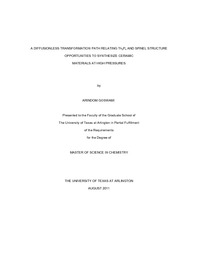
ATTENTION: The works hosted here are being migrated to a new repository that will consolidate resources, improve discoverability, and better show UTA's research impact on the global community. We will update authors as the migration progresses. Please see MavMatrix for more information.
Show simple item record
| dc.contributor.author | Goswami, Arindom | en_US |
| dc.date.accessioned | 2012-04-11T20:54:38Z | |
| dc.date.available | 2012-04-11T20:54:38Z | |
| dc.date.issued | 2012-04-11 | |
| dc.date.submitted | January 2011 | en_US |
| dc.identifier.other | DISS-11286 | en_US |
| dc.identifier.uri | http://hdl.handle.net/10106/9522 | |
| dc.description.abstract | Physical properties of solids at high pressure hold the key to many interesting questions in earth and planetary sciences, as well as in applied sciences. At high pressure, most ambient-pressure materials become unstable and transform into new and denser phases. In recent years, many solids with new structure types have been realized at high pressure through experiments and predicted in numerical simulations. Some of these structures are novel and had not been seen at ambient pressure. Some possess a variety of electronic states, i.e., metallic, superconducting, or super-hard states [YAO08]. These discoveries are of high interests both for their potential technological applications and contribute to the understanding of the fundamental aspects of electronic processes in solids such as chemical bonding. The study of physical properties of high-pressure solids is one research area that have greatly benefited from computational research. In experiments, high pressure can be attained, for instance, in diamond anvil cells. Adjusting pressure in computational studies can be accomplished straightforwardly by varying the size of unit cell. With the rapid developments of computational power and advanced software, theoretical studies of solids at high pressure bloom over the past two decades. The complexities of the materials that can be studied and the accuracy in which physical properties can be predicted have increased rapidly over the years. Computations with well-established first-principles methods have played an important role in exploring and guiding experiments at high pressure. Numerical simulations have now been established as an important tool in cooperation with experiments at high pressure. On the other hand, new experiments at high pressure continue to provide challenging tests for both theory and numerical methods, and help to further develop more sophisticated principles and algorithms [MON07]. | en_US |
| dc.description.sponsorship | Kroll, Peter | en_US |
| dc.language.iso | en | en_US |
| dc.publisher | Chemistry & Biochemistry | en_US |
| dc.title | A diffusionless transformation path relating Th₃P₄ and spinel structure opportunities to synthesize ceramic materials at high pressures | en_US |
| dc.type | M.S. | en_US |
| dc.contributor.committeeChair | Kroll, Peter | en_US |
| dc.degree.department | Chemistry & Biochemistry | en_US |
| dc.degree.discipline | Chemistry & Biochemistry | en_US |
| dc.degree.grantor | University of Texas at Arlington | en_US |
| dc.degree.level | masters | en_US |
| dc.degree.name | M.S. | en_US |
Files in this item
- Name:
- Goswami_uta_2502M_11286.pdf
- Size:
- 2.890Mb
- Format:
- PDF
This item appears in the following Collection(s)
Show simple item record


